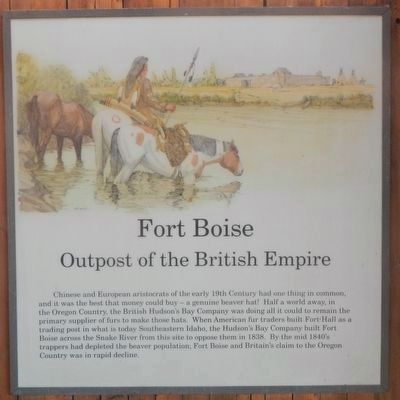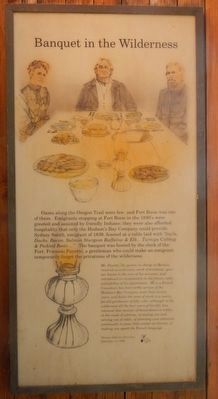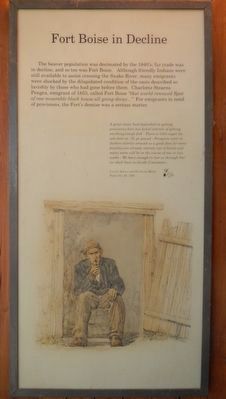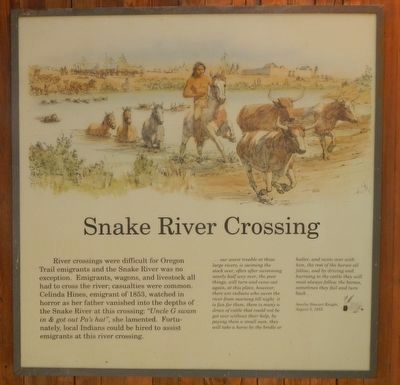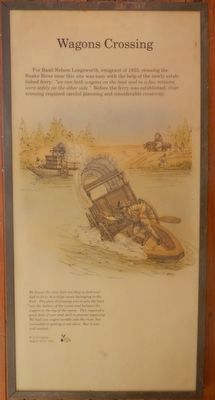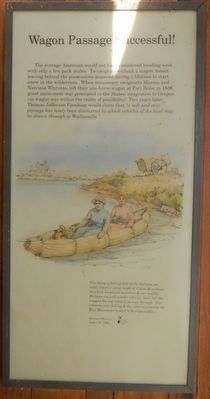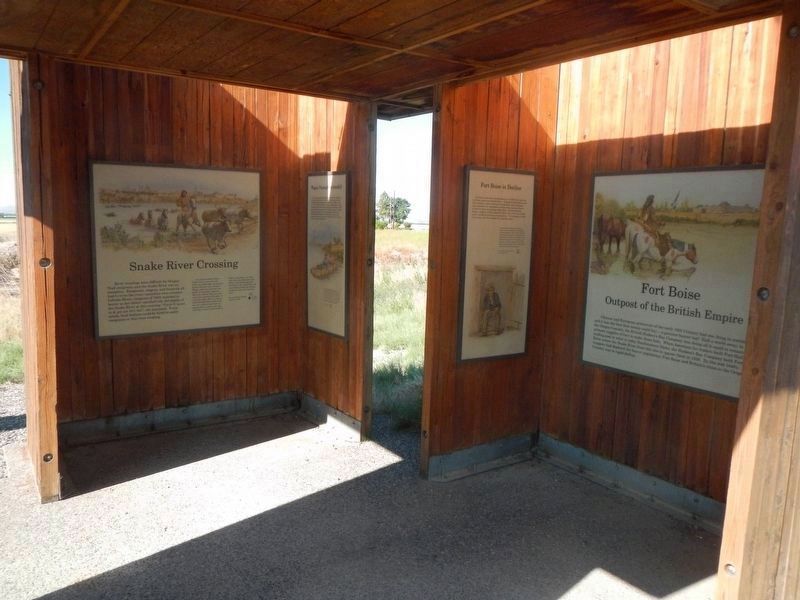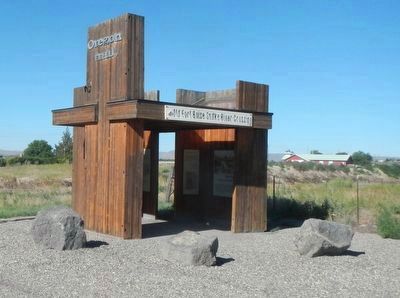Near Nyssa in Malheur County, Oregon — The American West (Northwest)
Old Fort Boise Snake River Crossing Kiosk
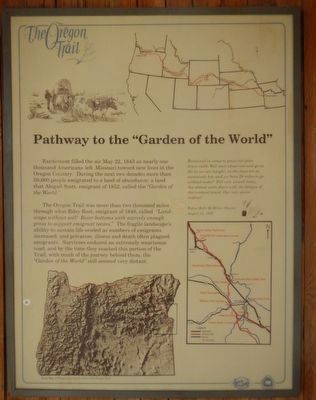
Photographed By Barry Swackhamer, June 28, 2017
1. "Pathway to the "Garden of the World"
Captions: (top right) Map of the Oregon Trail; (bottom left) Relief Map of Oregon showing the route of the Oregon Trail.: (center right) Remained in camp to graze our poor brave cattle. Will start about two and go as far as we can tonight, as the days are so excessively hot, and we have 28 miles to go without water! Felt very unwell today, Am almost worn down with the fatigue of constant travel. Our way seem endless! -- Esther Bell McMillan Hanna, August 13, 1852. (map of Oregon Trail sites near Ontario, Idaho.)
Excitement filled the air May 22, 1843 as nearly one thousand Americans left Missouri toward new lives in the Oregon Country. During the next two decades, more than 50,000 people emigrated to a land of abundance, a land that Abigail Scott, emigrant of 1852, called the "Garden of the World."
The Oregon Trail was more than two thousand miles through what Riley Root, emigrant of 1848, called "Landscape without soil! River bottoms with scarcely enough grass to support emigrant teams." The fragile landscape's ability to sustain life eroded as the numbers of emigrants increased and privation, illness and death often plagued emigrants. Survivors endured an extremely wearisome road, and by the time they reached this portion of the Trail, with much of the journey behind them, the "Garden of the World" still seemed very distant.
Chinese and European aristocrats of the early 19th Century had one thing in common, and it was the best money could buy - a genuine beaver hat! Half a world away, in the Oregon Country, the British Hudson's Bay Company was doing all it could to remain the primary supplier of furs to make those hats. When American fur traders built Fort Hall as a trading post in what is today Southeastern, Idaho, the Hudson's Bay Company built Fort Boise across the Snake River from this site to oppose them in 1838. By the mid 1840's trappers had depleted the beaver population; Fort Boise and Britain's claim to the Oregon Country was in rapid decline.
Oases along the Oregon Trail were few, and Fort Boise was one of them. Emigrants stopping at Fort Boise in the 1830's were greeted and assisted by friendly Indians; they were also afforded hospitality that only the Hudson's Bay Company could provide. Sydney Smith, emigrant of 1839, feasted at a table laid with "fowls, Ducks, Bacon, Salmon Sturgeon Buffalow & Elk... Turnips Cabbag & Pickled Beets..." The banquet was hosted by the clerk of the Fort, Francois Payette, a gentleman who could make an emigrant temporarily forget the privations of the wilderness.
Mr. Payette, the person in charge at Boisais, received us with every mark of kindness; gave our horses to the care of his servants, and introduced us immediately to the chairs, table and edibles of his apartments. He is a French Canadian; has been in the service of the Hudson's Bay Company more than twenty years, and holds the rank of clerk; is a merry fat old gentleman of fifty, who, although in the wilderness all the best years of his life, has retained that manner of benevolence in trifles, in his mode of address, of seating you and serving you at table, of directing your attention continually to some little matter of interest, of making you speak the French language. -- Thomas Jefferson Farnham, September 13, 1839
The beaver population was decimated by the 1840's; fur trade was in decline, as so too was Fort Boise. Although friendly Indians were still available to assist crossing the Snake River, many emigrants were shocked by the dilapidated condition of the oasis described so lavishly by those who had gone before them. Charlotte Sterns Pengra, emigrant of 1853, called Fort Boise "that world renowned Spot of one miserable block house all going decay..." For emigrants in need of provisions, the Fort's demise was a serious matter.
A great many had depended on getting provisions here but failed entirely of getting anything except fish - There is little sugar for sale here at .75, pr pound - Prospects seem to darken entirely around us a good deal for some families are already entirely out of bread and many more will be in the course of one or two weeks - We have enough to last us through but we shall have to divide if necessary. -- Cevelia Adams and Parthenia Blank, September 20 1852
River crossings were difficult for Oregon Trail emigrants and the Snake River was no exception. Emigrants, wagons, and livestock all has to cross the river; casualties were common. Celinda Hines, emigrant of 1853, watched in horror as her father vanished into the depths of the Snake River at this crossing: "Uncle G swam in & got out Pa's hat", she lamented. Fortunately, local Indians could be hired to assist emigrants at this river crossing.
... our worst trouble at these large rivers, is swiming the stock over, often after swimming nearly half way over, the poor things will turn and come out again, at this place, however, there are indians who swim the river from morning till night, it is fun for them, there is many a drove of cattle that could not be got over without their help, by paying them a small sum, they will take a horse by the bridle or halter, and swim over with him, the rest of the horses all follow, and by driving and hurraing to the cattle they will most always follow the horses, sometimes they fail and turn back... -Amelia Stewart Knight, August 5, 1853
For Basil Nelson Longsworth, emigrant of 1853, crossing the Snake River near this site was easy with the help of the newly established ferry: "we ran both wagons on the boat and in a few minutes were safely on the other side." Before the ferry was established, river crossing required careful planning and considerable creativity.
We found the river here too deep to ford and had to ferry in large canoe belonging to the Fort. The plan of crossing was to pile the load into the bottom of the canoe and balance the wagon on top of the canoe. This required a good deal of care and skill to prevent capsizing. We had one wagon tumble into the river, but succeeded in getting it out alive. But it was well soaked. P.V. Crawford, August 10-11, 1851.
The average American would not have considered heading west with only a few pack mules. To emigrate without a wagon meant leaving behind the possessions acquired during a lifetime to start anew in the wilderness. When missionary emigrants Marcus and Narcissa Whitman left their one-horse wagon at Fort Boise in 1836, great excitement was generated in the States: emigration to Oregon via wagon was within the realm of possibility! Two years later Thomas Jefferson Farnham would claim that "a safe and easy passage has lately been discovered by which vehicles of any kind may be drawn through to Wallawalla."
This being a fishing post of the Indians, we easily found a canoe made of rushes & willows on which we placed ourselves & our saddles... Perhaps you will wonder why we have left the waggon having taken it so near through. Our animals were failing & the route in crossing the Blue Mountains is said to be impassible... -- Narcissa Whitman, August 22, 1836
Topics. This historical marker is listed in these topic lists: Roads & Vehicles • Settlements & Settlers. A significant historical date for this entry is May 18, 1843.
Location. 43° 49.522′ N, 117° 2.235′ W. Marker is near Nyssa, Oregon, in Malheur County. Marker is on Succor Creek Highway (Oregon Route 201) near Adams Road, on the left when traveling north. Touch for map. Marker is at or near this postal address: 2717 Succor Creek Highway, Nyssa OR 97913, United States of America. Touch for directions.
Other nearby markers. At least 8 other markers are within 9 miles of this marker, measured as the crow flies. Starvation Camp (a few steps from this marker); Old Oregon Trail (a few steps from this marker); Fort Boise (approx. 6.1 miles away in Idaho); Marie Dorion (approx. 6.1 miles away in Idaho); Old Fort Boise (approx. 6.1 miles away in Idaho); a different marker also named Old Oregon Trail (approx. 6.1 miles away in Idaho); The South Alternate Route of the Oregon Trail (approx. 6.6 miles away); Imagine a Day's Journey (approx. 9.1 miles away).
Credits. This page was last revised on December 31, 2017. It was originally submitted on August 13, 2017, by Barry Swackhamer of Brentwood, California. This page has been viewed 560 times since then and 43 times this year. Photos: 1, 2, 3, 4, 5, 6, 7, 8, 9. submitted on August 13, 2017, by Barry Swackhamer of Brentwood, California.
